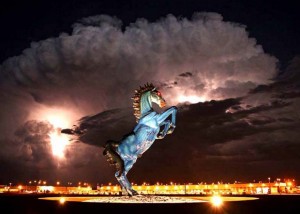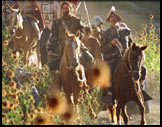My major is international studies, but surprisingly, I’ve spent a lot of time looking at art for classes lately. Art, as a form of popular culture, has this weird tendency to reflect, well, popular culture. It’s all around us, too. From Vermeer paintings reflecting 17th century Dutch hegemony to modern reflections of “globalization”, we can use art to learn just how much our world changes on a daily basis. From this, Purple-Hued Glasses was born. I hope to use art displayed around Denver’s purple mountain majesty as a lens to see broader global change around us. It’s odd, I know, but trust me—you’ll understand soon enough.

For my first post, I’m going to discuss a piece of art that sits at Denver International Airport, welcoming any newcomer to the city: the Blue Mustang, aka Blucifer. It’s not your typical welcome wagon; in reality, it’s actually quite horrifying. Complete with cobalt skin, rippling muscles and glowing, red eyes, its appearance alone is enough for anybody to turn back to the airport and hop on the next plane away from that horse. In fact, it killed its creator. That’s right – the sculptor, Luis Jiménez, died when a piece of the 9,000-pound sculpture fell on him and severed an artery in his leg. It’s no wonder that hairs rise on both Denverites and visitors alike when passing the statue.

As creepy as it is, it still opens up the discussion of the “Wild West”, which is what the statue is meant to represent. What is it about wild horses that’s supposed to represent the West, though? Weren’t horses used by Europeans to conquer the Americas? Indeed they were. However, the horse species equus is native to North America. It wasn’t until about 8,000-10,000 years ago that horses died out in North America. Only those in Europe and Asia (that had migrated across the Bering Strait) were left as the last living remnants of the species.

The species flourished in Europe and Asia in that time and human civilizations learned to use them as a tool. In the 16th century, Spanish conquistadors even brought their own horses back to North America. In a twisted sort of irony, they used horses to their advantage to kill and conquest civilizations on the very lands where the species originally started. It’s another chilling image to associate with this statue, but it also allowed horses to replenish their North American population, becoming a dominant species (and tool) once more.
Eventually, the growth of the species and the open range era of the mid-to-late 19th century created the image of cowboys across the great plains, using horses to rein in the wild cattle of the region. As a result, horses now conjure the idea of the “Wild West” through cowboys and rodeos. That’s likely the image that Blucifer is meant to invoke to passersby, even though it oftentimes frightens more than anything. In reality, though, a closer look through our purple-hued glasses can reveal a grand history of evolution, conquest and the sinister irony of an animal that once disappeared entirely from our continent.

